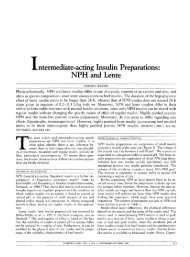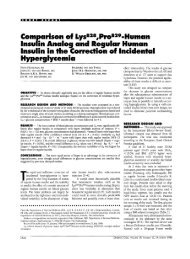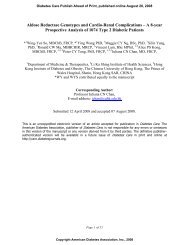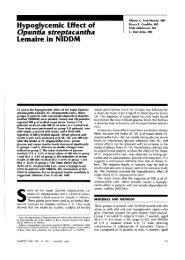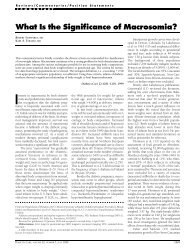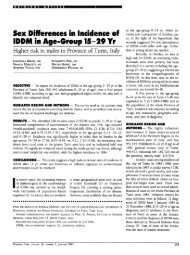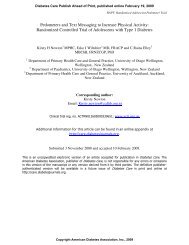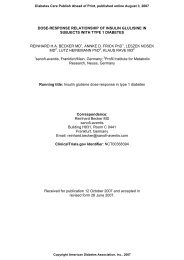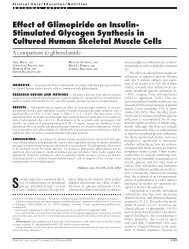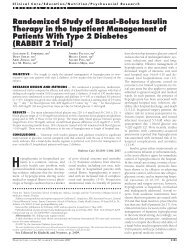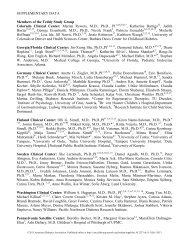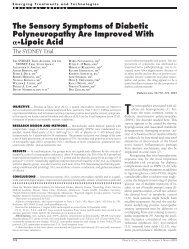Peripheral Total and Differential Leukocyte Count in ... - Diabetes Care
Peripheral Total and Differential Leukocyte Count in ... - Diabetes Care
Peripheral Total and Differential Leukocyte Count in ... - Diabetes Care
Create successful ePaper yourself
Turn your PDF publications into a flip-book with our unique Google optimized e-Paper software.
Pathophysiology/Complications<br />
O R I G I N A L A R T I C L E<br />
<strong>Peripheral</strong> <strong>Total</strong> <strong>and</strong> <strong>Differential</strong><br />
<strong>Leukocyte</strong> <strong>Count</strong> <strong>in</strong> Diabetic<br />
Nephropathy<br />
The relationship of plasma lept<strong>in</strong> to leukocytosis<br />
FU-MEI CHUNG, MS 1<br />
JACK C.-R. TSAI, MD 1<br />
DAO-MING CHANG, MD 1<br />
SHYI-JANG SHIN, MD, PHD 2<br />
YAU-JIUNN LEE, MD, PHD 1<br />
OBJECTIVE — Because of <strong>in</strong>creas<strong>in</strong>g evidence that white blood cells (WBCs) play a role <strong>in</strong><br />
the development <strong>and</strong> progression of diabetes complications, this study aimed to <strong>in</strong>vestigate the<br />
relation of circulat<strong>in</strong>g total <strong>and</strong> differential leukocyte counts to nephropathy <strong>in</strong> patients with type<br />
2 diabetes. Plasma lept<strong>in</strong> levels were also measured to <strong>in</strong>vestigate their role <strong>in</strong> peripheral leukocytosis.<br />
RESEARCH DESIGN AND METHODS — For this study, 1,480 subjects with type 2<br />
diabetes who were enrolled <strong>in</strong> a disease management program were stratified accord<strong>in</strong>g to<br />
ur<strong>in</strong>ary microalbum<strong>in</strong> <strong>and</strong> serum creat<strong>in</strong><strong>in</strong>e measurements. The total <strong>and</strong> differential leukocyte<br />
profiles of peripheral blood were measured <strong>and</strong> plasma lept<strong>in</strong> was exam<strong>in</strong>ed by enzyme-l<strong>in</strong>ked<br />
immunosorbent assay. Demographic <strong>and</strong> potential metabolic confound<strong>in</strong>g factors were analyzed<br />
with l<strong>in</strong>ear <strong>and</strong> logistic regression to calculate the effects of leukocyte count on diabetic<br />
nephropathy.<br />
RESULTS — The peripheral total WBC, monocyte, <strong>and</strong> neutrophil counts <strong>in</strong>creased <strong>in</strong> parallel<br />
with the advancement of diabetic nephropathy. In contrast, the lymphocyte count decreased.<br />
When WBC counts were analyzed per quartile <strong>and</strong> as cont<strong>in</strong>uous variables after<br />
adjust<strong>in</strong>g for age, sex, <strong>and</strong> other known risk factors with multiple regression analysis, peripheral<br />
total WBC, monocyte, neutrophil, <strong>and</strong> lymphocyte counts were <strong>in</strong>dependently <strong>and</strong> significantly<br />
associated with diabetic nephropathy. Plasma lept<strong>in</strong> levels <strong>in</strong>creased <strong>in</strong> patients with nephropathy<br />
<strong>and</strong> correlated significantly with total WBC count (r � 0.194, P � 0.014).<br />
CONCLUSIONS — Because leukocytes are activated <strong>and</strong> secrete cytok<strong>in</strong>es <strong>in</strong> the diabetic<br />
state <strong>and</strong> lept<strong>in</strong> stimulates leukocyte proliferation <strong>and</strong> differentiation, our results suggest that<br />
circulat<strong>in</strong>g leukocytes contribute to the development <strong>and</strong> progression of nephropathy, partially<br />
through the effects of lept<strong>in</strong>, <strong>in</strong> patients with type 2 diabetes.<br />
<strong>Diabetes</strong> <strong>Care</strong> 28:1710–1717, 2005<br />
●●●●●●●●●●●●●●●●●●●●●●●●●●●●●●●●●●●●●●●●●●●●●●●●●<br />
From the 1 Department of Cl<strong>in</strong>ical Research, P<strong>in</strong>gtung Christian Hospital, P<strong>in</strong>gtung, Taiwan; <strong>and</strong> the 2 Graduate<br />
Institute of Medic<strong>in</strong>e, Kaohsiung Medical University, Kaohsiung, Taiwan.<br />
Address correspondence <strong>and</strong> repr<strong>in</strong>t requests to Dr. Yau-Jiunn Lee, Department of Cl<strong>in</strong>ical Research,<br />
P<strong>in</strong>gtung Christian Hospital, No. 60, Da-Lien Rd., P<strong>in</strong>gtung, 90000 Taiwan. E-mail: t3275@ms25.h<strong>in</strong>et.net.<br />
Received for publication 24 December 2004 <strong>and</strong> accepted <strong>in</strong> revised form 6 April 2005.<br />
Abbreviations: CAD, coronary artery disease; CHD, coronary heart disease; DBP, diastolic blood pressure;<br />
NK-�B, nuclear factor �B; SBP, systolic blood pressure; TNF-�, tumor necrosis factor-�; UACR, ur<strong>in</strong>ary<br />
album<strong>in</strong>-to-creat<strong>in</strong><strong>in</strong>e ratio; WBC, white blood cell; WHR, waist-to-hip ratio.<br />
A table elsewhere <strong>in</strong> this issue shows conventional <strong>and</strong> Système International (SI) units <strong>and</strong> conversion<br />
factors for many substances.<br />
© 2005 by the American <strong>Diabetes</strong> Association.<br />
The costs of publication of this article were defrayed <strong>in</strong> part by the payment of page charges. This article must therefore be hereby<br />
marked “advertisement” <strong>in</strong> accordance with 18 U.S.C. Section 1734 solely to <strong>in</strong>dicate this fact.<br />
<strong>Peripheral</strong> white blood cell (WBC)<br />
count has been shown to be associated<br />
with <strong>in</strong>sul<strong>in</strong> resistance, type 2<br />
diabetes (1–4), coronary artery disease<br />
(CAD) (5–8), stroke (5,8), <strong>and</strong> diabetes<br />
micro- <strong>and</strong> macrovascular complications<br />
(9,10). An association between leukocytes<br />
counts <strong>and</strong> CAD has been observed<br />
<strong>in</strong> prospective <strong>and</strong> retrospective cohort<br />
studies as well as <strong>in</strong> case-control studies;<br />
this association persists after adjust<strong>in</strong>g for<br />
multiple coronary heart disease (CHD)<br />
risk factors, <strong>in</strong>clud<strong>in</strong>g smok<strong>in</strong>g (11).<br />
<strong>Peripheral</strong> blood leukocytes are composed<br />
of polymorphonuclear cells, <strong>in</strong>clud<strong>in</strong>g<br />
monocytes as well as<br />
lymphocytes. Polymorpho- <strong>and</strong> mononuclear<br />
leukocytes can be activated by advanced<br />
glycation end products (12),<br />
oxidative stress (13,14), angiotens<strong>in</strong> II<br />
(15), <strong>and</strong> cytok<strong>in</strong>es (16) <strong>in</strong> a state of hyperglycemia.<br />
<strong>Leukocyte</strong>s may be activated<br />
through the release of cytok<strong>in</strong>es,<br />
such as tumor necrosis factor-� (TNF-�)<br />
(17,18), transform<strong>in</strong>g growth factor �1<br />
(19), superoxide (20), nuclear factor �B<br />
(NF-�B) (21), monocyte chemoattractant<br />
prote<strong>in</strong> 1, <strong>in</strong>terleuk<strong>in</strong>-1�, <strong>and</strong> others (17)<br />
to participate <strong>in</strong> the pathogenesis of diabetic<br />
micro- <strong>and</strong> macrovascular complications.<br />
Elevated differential cell counts,<br />
<strong>in</strong>clud<strong>in</strong>g counts of eos<strong>in</strong>ophils, neutrophils,<br />
<strong>and</strong> monocytes, also predict the future<br />
<strong>in</strong>cidence of CAD (11,22,23).<br />
However, there is no research concern<strong>in</strong>g<br />
the differential leukocyte count <strong>in</strong> relation<br />
to diabetic nephropathy.<br />
The mechanism responsible for leukocytosis<br />
<strong>in</strong> obesity, diabetes, or atherosclerosis<br />
is largely unknown. It has been<br />
determ<strong>in</strong>ed that lept<strong>in</strong>, an adipocytok<strong>in</strong>e,<br />
serves as a satiety factor <strong>and</strong> plays an important<br />
role <strong>in</strong> regulat<strong>in</strong>g body weight,<br />
homeostasis, <strong>and</strong> energy balance (24).<br />
Recent evidence suggests that lept<strong>in</strong> <strong>and</strong><br />
the lept<strong>in</strong> receptor are parts of a pathway<br />
that stimulates hemopoiesis (25,26).<br />
The purpose of the present study was<br />
to <strong>in</strong>vestigate the amounts of peripheral<br />
1710 DIABETES CARE, VOLUME 28, NUMBER 7, JULY 2005
Table 1—Cl<strong>in</strong>ical characteristics of study subjects<br />
total <strong>and</strong> differential WBCs as they are<br />
altered <strong>and</strong> regulated by lept<strong>in</strong> <strong>in</strong> patients<br />
with diabetic nephropathy. We analyzed<br />
the peripheral total as well as differential<br />
WBC counts <strong>in</strong> type 2 diabetic patients <strong>in</strong><br />
various stages of nephropathy to clarify<br />
the role of peripheral leukocytes <strong>in</strong> the<br />
pathogenesis of diabetic nephropathy <strong>and</strong><br />
the role of plasma lept<strong>in</strong> <strong>in</strong> leukocytosis.<br />
RESEARCH DESIGN AND<br />
METHODS — Patients with type 2 diabetes<br />
who entered a disease management<br />
program at the Diabetic Cl<strong>in</strong>ic of the P<strong>in</strong>gtung<br />
Christian Hospital under the guidance<br />
of the National Health Bureau of<br />
Taiwan from January 2002 to June 2004<br />
were studied (27,28). The diagnosis of<br />
type 2 diabetes was based on World<br />
Health Organization criteria (29). Patients<br />
present<strong>in</strong>g with symptoms suggestive<br />
of type 1 diabetes, def<strong>in</strong>ed as diabetic<br />
ketoacidosis, acute presentation with<br />
heavy ketonuria (3�), or cont<strong>in</strong>uous requirement<br />
of <strong>in</strong>sul<strong>in</strong> with<strong>in</strong> 1 year of diagnosis,<br />
were excluded (30). Patients<br />
with a previous diagnosis of ur<strong>in</strong>ary tract<br />
<strong>in</strong>fection, urolithiasis, liver cirrhosis, congestive<br />
heart failure, chronic lung diseases,<br />
chronic otitis media, s<strong>in</strong>usitis,<br />
periodontitis (or undergo<strong>in</strong>g dental treatment),<br />
chronic viral hepatitis, pelvic <strong>in</strong>-<br />
Normoalbum<strong>in</strong>uria Microalbum<strong>in</strong>uria Overt nephropathy P<br />
n 888 326 266 —<br />
Sex (% female) 56.7 57.9 52.4 0.367<br />
Age (years) 58.8 � 11.6 62.0 � 11.8 63.6 � 11.2 �0.0001<br />
Duration of diabetes (years) 7.7 � 5.8 10.0 � 6.9 14.4 � 8.5 �0.0001<br />
BMI (kg/m 2 ) 25.5 � 3.6 25.8 � 4.0 24.8 � 3.9 0.004<br />
WHR 0.94 � 0.08 0.95 � 0.07 0.95 � 0.08 0.102<br />
SBP (mmHg) 138 � 21 150 � 20 156 � 20 �0.0001<br />
DBP (mmHg) 83 � 12 88 � 13 88 � 13 �0.0001<br />
Fast<strong>in</strong>g glucose (mmol/l) 9.0 � 3.1 9.9 � 3.6 10.5 � 4.0 �0.0001<br />
A1C (%) 8.2 � 2.1 8.8 � 2.1 9.0 � 2.3 �0.0001<br />
<strong>Total</strong> cholesterol (mmol/l) 5.06 � 1.09 5.26 � 1.15 5.46 � 1.39 �0.001<br />
Triglycerides (mmol/l) 1.72 � 1.88 2.02 � 1.61 2.50 � 5.70 0.001<br />
HDL cholesterol (mmol/l) 1.20 � 0.34 1.16 � 0.30 1.12 � 0.32 0.002<br />
LDL cholesterol (mmol/l) 3.07 � 0.88 3.21 � 1.00 3.31 � 0.98 0.001<br />
Uric acid (�mol/l) 333 � 89 357 � 101 410 � 113 �0.001<br />
Creat<strong>in</strong><strong>in</strong>e (�mol/l) 80 � 27 80 � 18 150 � 115 �0.0001<br />
Smokers (%) 20.0 21.7 21.4 0.780<br />
<strong>Diabetes</strong> medication (%) �0.0001<br />
Oral hypoglycemic agent 93.6 86.5 67.2<br />
Insul<strong>in</strong> 1.4 5.3 12.0<br />
Oral hypoglycemic agent � <strong>in</strong>sul<strong>in</strong> 5.0 8.2 20.8<br />
Data are means � SD. See def<strong>in</strong>ition of normo- <strong>and</strong> microalbum<strong>in</strong>uria <strong>and</strong> overt nephropathy <strong>in</strong> RESEARCH DESIGN AND METHODS.<br />
fection, or other known renal diseases were<br />
also excluded on the basis of <strong>in</strong>terview,<br />
physical exam<strong>in</strong>ation, <strong>and</strong> ur<strong>in</strong>alysis.<br />
Each patient participated <strong>in</strong> a detailed<br />
<strong>in</strong>terview of his or her personal disease<br />
<strong>and</strong> smok<strong>in</strong>g history. Information on<br />
smok<strong>in</strong>g habits was assessed by a st<strong>and</strong>ardized<br />
questionnaire. Patients’ smok<strong>in</strong>g<br />
status was classified as never hav<strong>in</strong>g<br />
smoked, former smoker (ceased smok<strong>in</strong>g<br />
for at least 1 year), or current smoker. In<br />
this study, former <strong>and</strong> current smokers<br />
were analyzed as a group <strong>and</strong> compared<br />
with those who had never smoked. All of<br />
the study subjects were of Han Ch<strong>in</strong>ese<br />
orig<strong>in</strong>, without any known ancestry of<br />
other ethnic orig<strong>in</strong>, <strong>and</strong> lived <strong>in</strong> the same<br />
region at the time of the study. The Human<br />
Research Ethics Committee of our<br />
hospital approved this study <strong>and</strong> <strong>in</strong>formed<br />
consent was obta<strong>in</strong>ed from each<br />
patient.<br />
All of the patients underwent complete<br />
physical exam<strong>in</strong>ation <strong>and</strong> rout<strong>in</strong>e<br />
biochemical analyses for blood <strong>and</strong> ur<strong>in</strong>e<br />
<strong>and</strong> were assessed for the presence <strong>and</strong><br />
extent of macro- or microvascular diabetes<br />
complications. Anthropometric parameters<br />
were used to calculate BMI <strong>and</strong><br />
the waist-to-hip ratio (WHR). A tra<strong>in</strong>ed<br />
nurse measured blood pressure with a<br />
digital automatic blood pressure monitor<br />
Chung <strong>and</strong> Associates<br />
(model HEM-907; Omron, Tokyo, Japan)<br />
after subjects had rested for 5 m<strong>in</strong>. Fast<strong>in</strong>g<br />
overnight blood <strong>and</strong> ur<strong>in</strong>e samples<br />
were collected for plasma biochemical parameters<br />
<strong>and</strong> ur<strong>in</strong>ary microalbum<strong>in</strong> analysis.<br />
Plasma biochemical parameters <strong>and</strong><br />
ur<strong>in</strong>ary album<strong>in</strong> concentrations were<br />
measured, as previously described<br />
(27,28).<br />
<strong>Peripheral</strong> leukocyte analyses <strong>in</strong>cluded<br />
total leukocyte counts <strong>and</strong> differential<br />
percentages of neutrophils,<br />
monocytes, lymphocytes, eos<strong>in</strong>ophils,<br />
<strong>and</strong> basophils us<strong>in</strong>g an automated cell<br />
counter (XE-2100 Hematology Alpha<br />
Transportation System; Sysmex, Kobe,<br />
Japan). The absolute count of a leukocyte<br />
subtype was calculated as the<br />
product of its respective differential<br />
percentage <strong>and</strong> total leukocyte count.<br />
To m<strong>in</strong>imize the confound<strong>in</strong>g effect of<br />
<strong>in</strong>fection, subjects with a WBC count<br />
�4.0 � 10 9 /l or �10.0 � 10 9 /l were<br />
rechecked for the analysis <strong>and</strong> exam<strong>in</strong>ed<br />
extensively for possible occult<br />
chronic <strong>in</strong>fections. Any specimen with<br />
abnormal or atypical leukocytes was reanalyzed<br />
<strong>and</strong> excluded. The laboratory<br />
analyses were under <strong>in</strong>ternal <strong>and</strong> external<br />
quality control at the laboratory of<br />
the College of American Pathologists<br />
surveys.<br />
DIABETES CARE, VOLUME 28, NUMBER 7, JULY 2005 1711
<strong>Leukocyte</strong> counts <strong>and</strong> diabetic nephropathy<br />
Table 2—<strong>Total</strong> <strong>and</strong> differential leukocyte counts of study subjects<br />
Diabetic patients were screened<br />
based on the results of the ur<strong>in</strong>ary analysis<br />
<strong>and</strong> ur<strong>in</strong>ary microalbum<strong>in</strong> <strong>and</strong> serum<br />
creat<strong>in</strong><strong>in</strong>e measurements. They<br />
Normoalbum<strong>in</strong>uria Microalbum<strong>in</strong>uria Overt nephropathy P<br />
n 888 326 266 —<br />
WBC count (10 9 /l)<br />
Means � SD 6,572 � 1,647 6,984 � 1,662 7,440 � 1,769 �0.0001<br />
Adjusted mean 6,555 6,962 7,407 �0.0001<br />
Neutrophil count (10 9 /l)<br />
Means � SD 3,730 � 1,283 4,101 � 1,432 4,742 � 1,590 �0.0001<br />
Adjusted mean 3,728 4,074 4,660 �0.0001<br />
Monocyte count (10 9 /l)<br />
Means � SD 440 � 158 482 � 173 553 � 237 �0.0001<br />
Adjusted mean 445 483 544 �0.0001<br />
Lymphocyte count (10 9 /l)<br />
Means � SD 2,222 � 736 2,206 � 701 1,937 � 769 �0.001<br />
Adjusted mean 2,197 2,206 1,997 0.0003<br />
Eos<strong>in</strong>ophil count (10 9 /l)<br />
Means � SD 152 � 139 171 � 245 194 � 146 0.002<br />
Adjusted mean 157 175 191 0.017<br />
Basophil count (10 9 /l)<br />
Means � SD 32 � 19 35 � 21 36 � 25 0.040<br />
Adjusted mean 32 35 36 0.031<br />
Plasma lept<strong>in</strong> (ng/ml)* 7.8 � 6.8 10.6 � 9.1 15.8 � 17.9 0.014<br />
See def<strong>in</strong>ition of normo- <strong>and</strong> microalbum<strong>in</strong>uria <strong>and</strong> overt nephropathy <strong>in</strong> RESEARCH DESIGN AND METHODS. Adjusted means were adjusted by sex, age, BMI, WHR, <strong>and</strong><br />
smok<strong>in</strong>g status. *Plasma lept<strong>in</strong> levels were measured <strong>in</strong> 50 normoalbum<strong>in</strong>uric, 50 microalbum<strong>in</strong>uric, <strong>and</strong> 63 overt nephropathic subjects.<br />
were classified as hav<strong>in</strong>g normal album<strong>in</strong>uria<br />
(ur<strong>in</strong>ary album<strong>in</strong>-to-creat<strong>in</strong><strong>in</strong>e<br />
ratio [UACR] �30 mg/g), microalbum<strong>in</strong>uria<br />
(UACR 30–300 mg/g, with at<br />
Table 3—Univariate <strong>and</strong> multivariate analysis of risk factors associated with diabetic nephropathy<br />
least two or more tests show<strong>in</strong>g significant<br />
results), or overt nephropathy<br />
(UACR �300 mg/g <strong>and</strong>/or serum creat<strong>in</strong><strong>in</strong>e<br />
�1.5 mg/dl).<br />
Simple Multiple<br />
Estimate P Estimate P 95% CI<br />
Age 0.015 � 0.002 �0.0001 — NS —<br />
Sex �0.082 � 0.050 0.104 — NS —<br />
Duration of diabetes 0.048 � 0.003 �0.0001 0.034 � 0.003 �0.0001 0.027–0.040<br />
BMI �0.012 � 0.007 0.079 — NS —<br />
WHR 0.718 � 0.318 0.024 — NS —<br />
Smok<strong>in</strong>g 0.039 � 0.062 0.525 — NS —<br />
SBP 0.014 � 0.001 �0.0001 0.010 � 0.001 �0.0001 0.008–0.012<br />
DBP 0.012 � 0.002 �0.0001 — NS —<br />
Fast<strong>in</strong>g glucose 0.003 � 0.000 �0.0001 0.001 � 0.000 0.001 0.001–0.002<br />
A1C 0.064 � 0.011 �0.0001 — NS —<br />
<strong>Total</strong> cholesterol 0.002 � 0.001 �0.0001 0.002 � 0.001 �0.0001 0.001–0.003<br />
Triglycerides 0.292 � 0.041 �0.0001 — NS —<br />
HDL cholesterol �0.008 � 0.002 �0.0001 �0.008 � 0.002 �0.0001 �0.012 to �0.005<br />
LDL cholesterol 0.002 � 0.001 0.001 — NS —<br />
WBC count 0.111 � 0.014 �0.0001 0.063 � 0.017 0.0002 0.029–0.097<br />
Neutrophil count 0.000 � 0.000 �0.0001 0.000 � 0.000 �0.001 0.000–0.000<br />
Monocyte count 0.001 � 0.000 �0.0001 0.001 � 0.000 �0.0001 0.000–0.001<br />
Lymphocyte count �0.000 � 0.000 �0.0001 �0.000 � 0.000 �0.0001 0.000–0.000<br />
Eos<strong>in</strong>ophil count 0.001 � 0.000 0.0002 — NS —<br />
Basophil count 0.003 � 0.001 0.039 — NS —<br />
Data are means � SE. In multiple l<strong>in</strong>ear stepwise regression analysis, all covariates were used for analysis (r 2 � 0.280, n � 1,480). NS, variable not accepted as<br />
significant for stepwise analysis.<br />
1712 DIABETES CARE, VOLUME 28, NUMBER 7, JULY 2005
Table 4—Prevalence of diabetic nephropathy categorized accord<strong>in</strong>g to total <strong>and</strong> differential white cell count quartiles <strong>and</strong> multivariate analysis<br />
of the impact of leukocyte count on diabetic nephropathy<br />
Plasma lept<strong>in</strong> measurement<br />
To <strong>in</strong>vestigate the mechanism responsible<br />
for leukocytosis associated with diabetic<br />
nephropathy, plasma lept<strong>in</strong> was measured<br />
from 163 r<strong>and</strong>omly selected diabetic<br />
subjects who had fasted overnight.<br />
Samples were kept at �80°C <strong>and</strong> were<br />
diluted 100-fold before the assay. The<br />
concentration of plasma lept<strong>in</strong> was determ<strong>in</strong>ed<br />
by a commercial, solid-phase enzyme-l<strong>in</strong>ked<br />
immunosorbent assay kit<br />
(Quantik<strong>in</strong>e Human Lept<strong>in</strong> Immunoassay;<br />
R&D Systems, M<strong>in</strong>neapolis, MN).<br />
The dilution curve was parallel to the<br />
st<strong>and</strong>ard curve. The <strong>in</strong>tra-assay coefficients<br />
of variation were 3.2–6.9% for values of<br />
15.6–283.3 pg/ml. The lept<strong>in</strong> measurement<br />
was done <strong>in</strong> a s<strong>in</strong>gle experiment.<br />
Statistical analysis<br />
Data are shown as means � SD, unless<br />
otherwise noted. All statistical analyses<br />
were performed us<strong>in</strong>g the Statistical Package<br />
for Social Science program (SPSS for<br />
W<strong>in</strong>dows, version 10.1; SPSS, Chicago,<br />
IL). ANOVA was used for between-group<br />
comparisons for cont<strong>in</strong>uous variables <strong>and</strong><br />
the � 2 test was used for categorical variables.<br />
Because the distribution of serum<br />
triglycerides <strong>and</strong> plasma lept<strong>in</strong> levels was<br />
skewed, logarithmically transformed val-<br />
1st quartile 2nd quartile 3rd quartile 4th quartile P for trend<br />
<strong>Total</strong> WBC count 2.55–5.59 5.60–6.66 6.67–7.83 7.84–11.94 �0.001<br />
Normoalbum<strong>in</strong>uria (%) 72.3 60.7 58.2 49.5 �0.0001<br />
Microalbum<strong>in</strong>uria (%) 17.7 22.8 23.2 23.7 �0.0001<br />
Overt nephropathy (%) 10.1 16.5 18.6 26.9 0.001<br />
Multivariate 1.0 2.0 (1.33–3.10) 2.4 (1.59–3.70) 4.2 (2.77–6.40) —<br />
Neutrophil count 1,005–2,979 2,980–3,741 3,742–4,772 4,773–10,341 �0.001<br />
Normoalbum<strong>in</strong>uria (%) 72.7 64.9 59.2 43.8 �0.0001<br />
Microalbum<strong>in</strong>uria (%) 18.7 22.4 22.4 23.8 �0.0001<br />
Overt nephropathy (%) 8.7 12.7 18.4 32.4 0.019<br />
Multivariate 1.0 1.6 (1.00–2.41) 2.5 (1.65–3.87) 5.5 (3.64–8.40) —<br />
Monocyte count 47.9–341 342–433 434–559 560–1685 �0.001<br />
Normoalbum<strong>in</strong>uria (%) 67.8 68.2 60.3 44.3 �0.0001<br />
Microalbum<strong>in</strong>uria (%) 20.1 19.1 22.2 26.0 0.019<br />
Overt nephropathy (%) 12.2 12.7 17.6 29.7 0.995<br />
Multivariate 1.0 1.1 (0.69–1.62) 1.7 (1.13–2.56) 3.5 (2.36–5.30) —<br />
Lymphocyte count 221–1,622 1,623–2,067 2,068–2,580 2,581–5,958 �0.001<br />
Normoalbum<strong>in</strong>uria (%) 54.3 60.0 63.8 62.4 0.0001<br />
Microalbum<strong>in</strong>uria (%) 17.8 23.0 22.2 24.3 �0.0001<br />
Overt nephropathy (%) 27.8 17.0 14.1 13.2 0.006<br />
Multivariate 1.0 0.7 (0.46–0.99) 0.6 (0.38–0.83) 0.6 (0.43–0.95) —<br />
Data are odds ratios (95% CI) <strong>and</strong> are adjusted for age, sex, BMI, WHR, <strong>and</strong> smok<strong>in</strong>g status. See def<strong>in</strong>ition <strong>and</strong> criteria of diabetic nephropathy <strong>in</strong> RESEARCH DESIGN<br />
AND METHODS. Patients with normoalbum<strong>in</strong>uria were used as a reference, <strong>and</strong> the sum of patients with microalbum<strong>in</strong>uria <strong>and</strong> overt nephropathy were used as cases.<br />
ues were used for statistical analysis.<br />
Mean total <strong>and</strong> differential WBC counts<br />
were calculated across the categorized diabetic<br />
nephropathy.<br />
The general l<strong>in</strong>ear model<strong>in</strong>g function<br />
analysis was used to control for potential<br />
confounders other than age (e.g., sex,<br />
BMI, WHR, smok<strong>in</strong>g status). The association<br />
between diabetic nephropathy <strong>and</strong><br />
all other parameters was first analyzed by<br />
univariate analysis <strong>and</strong> then by multivariate<br />
l<strong>in</strong>ear stepwise regression analysis. In<br />
the regression analysis, known conventional<br />
risk factors for cardiovascular diseases<br />
were <strong>in</strong>cluded as covariates <strong>in</strong> the<br />
f<strong>in</strong>al model. WBC counts were grouped<br />
<strong>in</strong>to quartiles <strong>and</strong> the multivariateadjusted<br />
odds ratios (ORs) were presented<br />
with 95% CI. These quartiles were<br />
computed with the lowest category as the<br />
reference group.<br />
The relation between total <strong>and</strong> differential<br />
leukocytes counts <strong>and</strong> anthropometric<br />
<strong>and</strong> biochemical parameters,<br />
<strong>in</strong>clud<strong>in</strong>g plasma lept<strong>in</strong> concentrations,<br />
was exam<strong>in</strong>ed us<strong>in</strong>g Pearson’s correlation<br />
coefficients with two-tailed tests of significance.<br />
P �0.05 was considered significant.<br />
RESULTS — A total of 1,480 type 2 diabetic<br />
patients were <strong>in</strong>cluded <strong>in</strong> this<br />
Chung <strong>and</strong> Associates<br />
cross-sectional study. The cl<strong>in</strong>ical characteristics<br />
of the patients stratified by nephropathy<br />
status are given <strong>in</strong> Table 1. The<br />
prevalence of normoalbum<strong>in</strong>uria, microalbum<strong>in</strong>uria,<br />
<strong>and</strong> overt nephropathy<br />
<strong>in</strong> the present study was 60.0, 22.0, <strong>and</strong><br />
18.0%, respectively. Patients with nephropathy<br />
were older <strong>and</strong> had a longer<br />
duration of diabetes; higher systolic<br />
blood pressure (SBP) <strong>and</strong> diastolic<br />
blood pressure (DBP); higher fast<strong>in</strong>g<br />
glucose, HbA 1c (A1C), total <strong>and</strong> LDL<br />
cholesterol, triglycerides, uric acid, <strong>and</strong><br />
creat<strong>in</strong><strong>in</strong>e levels; <strong>and</strong> lower HDL cholesterol<br />
concentrations <strong>and</strong> BMI values<br />
than those without album<strong>in</strong>uria. Smok<strong>in</strong>g<br />
profiles were not different among<br />
the study groups. Patients with overt<br />
nephropathy had a higher prevalence of<br />
<strong>in</strong>sul<strong>in</strong> treatment.<br />
There was a significant trend <strong>in</strong> total<br />
<strong>and</strong> differential leukocyte counts (P �<br />
0.05 by ANOVA) across the three study<br />
groups, with the ma<strong>in</strong> difference be<strong>in</strong>g<br />
detected between overt nephropathic <strong>and</strong><br />
normoalbum<strong>in</strong>uric subjects. The mean<br />
peripheral total WBC, neutrophil, monocyte,<br />
eos<strong>in</strong>ophil, <strong>and</strong> basophil counts<br />
<strong>in</strong>creased, whereas, <strong>in</strong> contrast, the lymphocyte<br />
count decreased parallel to the<br />
severity of nephropathy (Table 2). Adjust-<br />
DIABETES CARE, VOLUME 28, NUMBER 7, JULY 2005 1713
<strong>Leukocyte</strong> counts <strong>and</strong> diabetic nephropathy<br />
Table 5—Pearson’s correlation analysis of peripheral total <strong>and</strong> differential leukocyte counts with metabolic parameters<br />
ments for age, sex, BMI, WHR, <strong>and</strong> smok<strong>in</strong>g<br />
status did not affect the significance of<br />
these differences.<br />
Univariate analyses revealed that age;<br />
duration of diabetes; WHR; systolic <strong>and</strong><br />
DBP; fast<strong>in</strong>g glucose; A1C; triglycerides;<br />
total, HDL, <strong>and</strong> LDL cholesterol; <strong>and</strong> total<br />
<strong>and</strong> differential leukocytes counts were all<br />
associated with diabetic nephropathy<br />
(Table 3). A multiple l<strong>in</strong>ear stepwise regression<br />
analysis was performed with the<br />
stages of diabetic nephropathy as the dependent<br />
variables; the nephropathy status<br />
was predictive of the follow<strong>in</strong>g<br />
variables: age; sex; known duration of diabetes;<br />
smok<strong>in</strong>g status; BMI; WHR; systolic<br />
<strong>and</strong> DBP; fast<strong>in</strong>g plasma glucose;<br />
A1C; triglycerides; total, HDL, <strong>and</strong> LDL<br />
cholesterol; <strong>and</strong> total <strong>and</strong> differential leukocytes<br />
counts. Our analysis showed that<br />
the duration of diabetes, SBP, fast<strong>in</strong>g<br />
plasma glucose, total <strong>and</strong> HDL cholesterol,<br />
<strong>and</strong> total leukocyte, neutrophil,<br />
monocyte, <strong>and</strong> lymphocyte counts were<br />
<strong>in</strong>dependent risk factors for diabetic<br />
nephropathy (r 2 � 0.280, P � 0.001)<br />
(Table 3).<br />
When subjects were divided <strong>in</strong>to<br />
quartiles accord<strong>in</strong>g to total WBC, neutrophil,<br />
monocyte, <strong>and</strong> lymphocyte counts,<br />
the prevalence of diabetic nephropathy<br />
was significantly (P � 0.001) associated<br />
with the leukocyte count (Table 4). Multiple<br />
logistic regression analysis ORs for<br />
the risk of the presence/absence of nephropathy<br />
<strong>in</strong> the 1st, 2nd, <strong>and</strong> 3rd quartiles,<br />
adjusted for age, sex, BMI, WHR,<br />
<strong>Total</strong> WBC count Monocyte count Neutrophil count Lymphocyte count<br />
r P r P r P r P<br />
Age �0.016 0.527 0.091 �0.001 0.082 0.002 �0.214 �0.001<br />
Sex �0.032 0.226 �0.169 �0.001 �0.028 0.284 0.055 0.035<br />
BMI 0.119 �0.001 0.038 0.141 0.047 0.069 0.164 �0.001<br />
WHR 0.069 0.009 0.056 0.032 0.099 �0.001 �0.045 0.091<br />
Fast<strong>in</strong>g glucose 0.056 0.032 0.032 0.221 0.088 0.001 �0.045 0.088<br />
A1C 0.060 0.022 0.081 0.002 0.071 0.007 �0.013 0.622<br />
SBP 0.091 �0.001 0.073 0.005 0.125 �0.001 �0.054 0.039<br />
DBP 0.079 0.002 0.040 0.131 0.066 0.012 0.038 0.145<br />
<strong>Total</strong> cholesterol 0.067 0.010 0.026 0.323 0.064 0.014 0.029 0.262<br />
Triglycerides 0.095 �0.001 0.016 0.545 0.070 0.008 0.080 0.002<br />
HDL cholesterol �0.134 �0.001 �0.144 �0.001 �0.107 �0.001 �0.042 0.110<br />
LDL cholesterol 0.057 0.031 0.036 0.166 0.075 0.004 �0.015 0.556<br />
Uric acid 0.071 0.022 0.113 �0.001 0.080 0.010 �0.049 0.115<br />
Creat<strong>in</strong><strong>in</strong>e 0.098 �0.001 0.174 �0.001 0.151 �0.001 �0.128 �0.001<br />
UACR 0.078 0.007 0.071 0.013 0.137 �0.001 �0.103 �0.001<br />
Smok<strong>in</strong>g status 0.108 �0.001 0.154 �0.001 0.069 0.008 0.052 0.045<br />
<strong>and</strong> smok<strong>in</strong>g status, were significantly<br />
<strong>and</strong> positively associated with total WBC,<br />
neutrophil, <strong>and</strong> monocyte counts <strong>and</strong><br />
negatively associated with lymphocyte<br />
count. The total WBC count showed a significant<br />
correlation with all parameters of<br />
the metabolic syndrome, such as BMI;<br />
WHR; fast<strong>in</strong>g plasma glucose; A1C; systolic<br />
<strong>and</strong> DBP; triglycerides; total, HDL,<br />
<strong>and</strong> LDL cholesterol; uric acid; creat<strong>in</strong><strong>in</strong>e;<br />
UACR; <strong>and</strong> smok<strong>in</strong>g status (Table 5). The<br />
monocyte counts were correlated with<br />
age, sex, WHR, A1C, SBP, HDL cholesterol,<br />
uric acid, creat<strong>in</strong><strong>in</strong>e, UACR, <strong>and</strong><br />
smok<strong>in</strong>g status. In one <strong>in</strong>terest<strong>in</strong>g f<strong>in</strong>d<strong>in</strong>g,<br />
the peripheral neutrophil count correlated<br />
well with all parameters <strong>in</strong>cluded<br />
<strong>in</strong> this study except for sex <strong>and</strong> BMI. The<br />
lymphocyte count correlated negatively<br />
with age, SBP, serum creat<strong>in</strong><strong>in</strong>e, <strong>and</strong> the<br />
UACR, <strong>and</strong> positively with sex, BMI, triglyceride<br />
levels, <strong>and</strong> smok<strong>in</strong>g status.<br />
The mean plasma lept<strong>in</strong> concentrations<br />
<strong>in</strong> 50 patients with normoalbum<strong>in</strong>uria,<br />
50 patients with microalbum<strong>in</strong>uria,<br />
<strong>and</strong> 63 patients with overt nephropathy<br />
were 7.8 � 6.8, 10.6 � 9.1, <strong>and</strong> 15.8 �<br />
17.9 ng/ml, respectively. There was a significant<br />
trend <strong>in</strong> serum lept<strong>in</strong> concentrations<br />
(P � 0.014 by ANOVA) (Table 2)<br />
across the three groups, with the ma<strong>in</strong><br />
difference be<strong>in</strong>g detected between overt<br />
nephropathic <strong>and</strong> normoalbum<strong>in</strong>uric<br />
subjects. Us<strong>in</strong>g Pearson’s correlation<br />
analysis, plasma lept<strong>in</strong> levels were significantly<br />
associated with total WBC counts<br />
(r � 0.194, P � 0.014), whereas plasma<br />
lept<strong>in</strong> levels were not correlated with <strong>in</strong>dividual<br />
differential leukocyte counts.<br />
The association still existed after adjust<strong>in</strong>g<br />
for age, sex, WHR, <strong>and</strong> smok<strong>in</strong>g status<br />
by multiple l<strong>in</strong>ear regression analysis (estimate<br />
� 0.028, P � 0.0082).<br />
CONCLUSIONS — Our study showed<br />
that peripheral total leukocyte, neutrophil,<br />
monocyte, <strong>and</strong> lymphocyte counts, even<br />
with<strong>in</strong> the normal range, are <strong>in</strong>dependently<br />
associated with nephropathy <strong>in</strong> subjects<br />
with type 2 diabetes <strong>in</strong> a dosage-related<br />
manner. The association between leukocytes<br />
<strong>and</strong> diabetic nephropathy persists<br />
even after controll<strong>in</strong>g for conventional risk<br />
factors, <strong>in</strong>clud<strong>in</strong>g age, sex, smok<strong>in</strong>g status,<br />
blood pressure, lipid profile, <strong>and</strong> glucose<br />
control, as well as obesity. Furthermore, the<br />
plasma lept<strong>in</strong> concentration was <strong>in</strong>creased<br />
<strong>in</strong> patients with nephropathy <strong>and</strong> correlated<br />
well with the peripheral total leukocyte<br />
counts. These f<strong>in</strong>d<strong>in</strong>gs are consistent<br />
with current evidence regard<strong>in</strong>g the association<br />
of <strong>in</strong>flammatory markers, <strong>in</strong>clud<strong>in</strong>g<br />
WBC count, with the development of diabetic<br />
microvascular <strong>and</strong> macrovascular<br />
complications (9,10).<br />
Numerous epidemiological <strong>and</strong> cl<strong>in</strong>ical<br />
studies have shown leukocytosis to be<br />
an <strong>in</strong>dependent predictor of <strong>in</strong>sul<strong>in</strong> resistance,<br />
type 2 diabetes, micro- <strong>and</strong> macrovascular<br />
complication of diabetes, <strong>and</strong><br />
future cardiovascular events <strong>in</strong> patients<br />
with stable ang<strong>in</strong>a, unstable ang<strong>in</strong>a, or a<br />
history of myocardial <strong>in</strong>farction (1–8).<br />
The differential cell counts, <strong>in</strong>clud<strong>in</strong>g<br />
1714 DIABETES CARE, VOLUME 28, NUMBER 7, JULY 2005
counts of eos<strong>in</strong>ophils, neutrophils, <strong>and</strong><br />
monocytes, also predict the future <strong>in</strong>cidence<br />
of CHD (11,22,23). Although there<br />
is no research report<strong>in</strong>g the differential<br />
leukocyte count <strong>in</strong> relation to diabetic nephropathy,<br />
our study clarifies that the<br />
composite members of WBC, especially<br />
the neutrophils <strong>and</strong> mononuclear cells<br />
(monocytes <strong>and</strong> lymphocytes), are associated<br />
with nephropathy <strong>in</strong> type 2 diabetic<br />
patients. To the best of our<br />
knowledge, ours is the first report to demonstrate<br />
that peripheral neutrophil,<br />
monocyte, <strong>and</strong> lymphocyte counts are associated<br />
with diabetic nephropathy.<br />
The mechanism responsible for the<br />
<strong>in</strong>creased total <strong>and</strong> differential leukocytes<br />
<strong>in</strong> diabetic patients with nephropathy is a<br />
matter of speculation. A plausible hypothesis<br />
is that lept<strong>in</strong> might be <strong>in</strong>volved<br />
<strong>in</strong> <strong>in</strong>creased leukocyte counts (25,26).<br />
Lept<strong>in</strong> has been reported to stimulate myeloid<br />
differentiation from human bone<br />
marrow CD34� progenitors (25) <strong>and</strong> can<br />
<strong>in</strong>duce proliferation, differentiation, <strong>and</strong><br />
functional activation of hemopoietic cells<br />
(26). We measured plasma lept<strong>in</strong> concentrations<br />
<strong>and</strong> confirmed previous reports<br />
that plasma lept<strong>in</strong> levels are <strong>in</strong>creased <strong>in</strong><br />
patients with diabetic nephropathy (31).<br />
Furthermore, our results showed that<br />
plasma lept<strong>in</strong> levels correlate well with total<br />
leukocyte count. We propose that lept<strong>in</strong><br />
may enhance the release <strong>and</strong> activation<br />
of leukocyte from bone marrow <strong>and</strong> contribute<br />
to the development <strong>and</strong> progression<br />
of diabetic nephropathy.<br />
Other mechanisms contribut<strong>in</strong>g to<br />
leukocytosis <strong>in</strong> patients with nephropathy<br />
may be related to plasma cortisol <strong>and</strong><br />
the chang<strong>in</strong>g <strong>in</strong>sul<strong>in</strong> levels <strong>in</strong> renal disease.<br />
Both factors are known to <strong>in</strong>crease<br />
WBC counts by <strong>in</strong>creas<strong>in</strong>g neutrophil <strong>in</strong>flux<br />
from marrow storage <strong>and</strong> decreas<strong>in</strong>g<br />
efflux from the blood stream (32,33). In<br />
addition, cortisol <strong>and</strong> <strong>in</strong>sul<strong>in</strong> may <strong>in</strong>crease<br />
the WBC count by stimulat<strong>in</strong>g lept<strong>in</strong><br />
secretion from adipocytes (34).<br />
The biological mechanisms by which<br />
leukocytes might <strong>in</strong>fluence the development<br />
<strong>and</strong> progression of diabetic nephropathy<br />
are multiple <strong>and</strong> protean. Data<br />
from research show that leukocytes play<br />
an important role <strong>in</strong> the <strong>in</strong>itiation <strong>and</strong><br />
progression of renal disease, <strong>in</strong>clud<strong>in</strong>g <strong>in</strong>flammatory<br />
mechanisms <strong>in</strong>dependent of<br />
<strong>in</strong>fection, caus<strong>in</strong>g proteolytic <strong>and</strong> oxidative<br />
damage to the mesangial cells (17).<br />
Macrophages <strong>and</strong> lymphocytes are prom<strong>in</strong>ent<br />
<strong>in</strong> the human glomeruli of diabetic<br />
nephropathy, even <strong>in</strong> the earliest stages of<br />
the disease process (35). WBCs <strong>in</strong> diabetic<br />
patients may be activated by advanced<br />
glycation end products or reactive<br />
oxygen species (12–14) <strong>and</strong> cytok<strong>in</strong>es<br />
(16). Activated leukocytes secrete many<br />
k<strong>in</strong>ds of cytok<strong>in</strong>es <strong>and</strong> transcription factors<br />
that have a crucial role <strong>in</strong> <strong>in</strong>flammation,<br />
<strong>in</strong>clud<strong>in</strong>g TNF-�, NF-�B,<br />
<strong>in</strong>terleuk<strong>in</strong>-1�, <strong>and</strong> transform<strong>in</strong>g growth<br />
factor �, thereby contribut<strong>in</strong>g to glomerulosclerosis<br />
(17–21).<br />
In addition, activated leukocytes can<br />
release superoxide radicals <strong>and</strong> proteases,<br />
all of which promote oxidative stress (20).<br />
The latter can then activate the transcription<br />
of NF-�B <strong>in</strong> peripheral mononuclear<br />
blood cells (14,21). All of these pathways<br />
can lead to diabetic nephropathy. Taken<br />
together, it is plausible that low-grade<br />
chronic <strong>in</strong>flammatory responses can <strong>in</strong>teract<br />
with other risk factors, lead<strong>in</strong>g to<br />
widespread vascular damage, endothelial<br />
dysfunction, <strong>in</strong>creased oxidative stress,<br />
<strong>and</strong> <strong>in</strong>creased production of growth factors<br />
<strong>and</strong> cytok<strong>in</strong>es, thereby caus<strong>in</strong>g renal<br />
damage.<br />
The peripheral lymphocyte count was<br />
<strong>in</strong>versely related to the severity of diabetic<br />
nephropathy <strong>in</strong> the present study. In a<br />
retrospective study of CAD patients, the<br />
5-year survival rate was significantly better<br />
for patients who had a normal lymphocyte<br />
count as compared with those<br />
with a relatively low lymphocyte count<br />
(36). Studies of patients with congestive<br />
heart failure have also identified lymphocyte<br />
counts or a low percentage of lymphocytes<br />
as an adverse prognostic factor<br />
(37). The mechanism for the decrease <strong>in</strong><br />
lymphocyte counts <strong>in</strong> patients with diabetic<br />
nephropathy or cardiovascular disease<br />
is still largely unknown. Our study<br />
revealed that peripheral lymphocyte<br />
counts are negatively associated with SBP;<br />
serum uric acid levels may provide some<br />
clues <strong>in</strong>to the role of peripheral lymphocytes<br />
<strong>in</strong> protection from diabetic<br />
nephropathy.<br />
One limitation of our study was its<br />
cross-sectional design, which limited our<br />
ability to <strong>in</strong>fer a causal relation between<br />
total <strong>and</strong> differential WBCs <strong>and</strong> diabetic<br />
nephropathy. Our analyses were based on<br />
a s<strong>in</strong>gle measurement of WBC counts that<br />
may not reflect the relation over time. It<br />
would be <strong>in</strong>terest<strong>in</strong>g to measure the serial<br />
changes of WBC counts to further clarify<br />
the role of WBCs <strong>in</strong> the development of<br />
diabetic nephropathy. It would also be<br />
Chung <strong>and</strong> Associates<br />
useful to know if the WBC measurements<br />
are stable over time. The bias effect of<br />
such measurement should be attenuated<br />
by a larger number of patients enrolled.<br />
In addition, although we controlled<br />
for major risk factors, <strong>in</strong>clud<strong>in</strong>g potential<br />
confounders such as hypertension, dyslipidemia,<br />
BMI, WHR, <strong>and</strong> smok<strong>in</strong>g, the<br />
existence of unrecognized confound<strong>in</strong>g<br />
variables is always possible. Smok<strong>in</strong>g status<br />
did not appear to have an additive effect<br />
on the prevalence of microvascular<br />
complications <strong>in</strong> our study, unlike the<br />
case with macrovascular complications.<br />
Although we extensively surveyed for the<br />
presence of a chronic <strong>in</strong>fection state that<br />
could affect the WBC count, some<br />
chronic <strong>in</strong>fections still could not be controlled<br />
for <strong>in</strong> the present study <strong>and</strong> might<br />
have been potential confound<strong>in</strong>g factors.<br />
These <strong>in</strong>clude chronic <strong>in</strong>fections with<br />
Chlamydia pneumonia, Helicobacter pylori,<br />
cytomegalovirus, <strong>and</strong> other organisms<br />
that have been postulated as<br />
potential risk factors for atherosclerosis<br />
(38).<br />
F<strong>in</strong>ally, this study did not provide serological<br />
data on <strong>in</strong>fection or other markers<br />
of <strong>in</strong>flammation, such as C-reactive<br />
prote<strong>in</strong>, TNF-�, or leukocyte adhesion<br />
molecules. Future studies should focus<br />
on whether differential WBCs are activated<br />
to secrete specific cytok<strong>in</strong>e markers<br />
<strong>in</strong>volved <strong>in</strong> the pathogenesis of diabetic<br />
nephropathy.<br />
In conclusion, our study showed that<br />
the peripheral total WBC, neutrophil,<br />
monocyte, <strong>and</strong> lymphocyte counts are associated<br />
with diabetic nephropathy.<br />
Plasma lept<strong>in</strong> concentrations are <strong>in</strong>creased<br />
<strong>in</strong> patients with nephropathy <strong>and</strong><br />
associated with leukocytosis <strong>in</strong> patients<br />
with type 2 diabetes.<br />
Acknowledgments— This work was supported<br />
by a grant from the National Science<br />
Council of Taiwan (93-2314-B-475-002).<br />
We are grateful to the staff of the diabetes<br />
care team for their assistance <strong>in</strong> the various<br />
measurements <strong>and</strong> other organizational aspects<br />
of this study.<br />
References<br />
1. Schmidt MI, Duncan BB, Sharrett AR,<br />
L<strong>in</strong>dberg G, Savage PJ, Offenbacher S,<br />
Azambuja MI, Tracy RP, Heiss G: Markers<br />
of <strong>in</strong>flammation <strong>and</strong> prediction of diabetes<br />
mellitus <strong>in</strong> adults (Atherosclerosis Risk<br />
<strong>in</strong> Communities Study): a cohort study.<br />
DIABETES CARE, VOLUME 28, NUMBER 7, JULY 2005 1715
<strong>Leukocyte</strong> counts <strong>and</strong> diabetic nephropathy<br />
Lancet 353:1649–1652, 1999<br />
2. Vozarova B, Weyer C, L<strong>in</strong>dsay RS, Pratley<br />
RE, Bogardus C, Tataranni PA: High white<br />
blood cell count is associated with a worsen<strong>in</strong>g<br />
of <strong>in</strong>sul<strong>in</strong> sensitivity <strong>and</strong> predicts<br />
the development of type 2 diabetes. <strong>Diabetes</strong><br />
51:455–461, 2002<br />
3. Ford ES: <strong>Leukocyte</strong> count, erythrocyte<br />
sedimentation rate, <strong>and</strong> diabetes <strong>in</strong>cidence<br />
<strong>in</strong> a national sample of US adults.<br />
Am J Epidemiol 155:57–64, 2002<br />
4. Ohshita K, Yamane K, Hanafusa M, Mori<br />
H, Mito K, Okubo M, Hara H, Kohno N:<br />
Elevated white blood cell count <strong>in</strong> subjects<br />
with impaired glucose tolerance. <strong>Diabetes</strong><br />
<strong>Care</strong> 27:491–496, 2004<br />
5. Kannel WB, Anderson K, Wilson PW:<br />
White blood cell count <strong>and</strong> cardiovascular<br />
disease: <strong>in</strong>sights from the Fram<strong>in</strong>gham<br />
Study. JAMA 267:1253–1256, 1992<br />
6. Weijenberg MP, Feskens EJ, Kromhout D:<br />
White blood cell count <strong>and</strong> the risk of<br />
coronary heart disease <strong>and</strong> all-cause mortality<br />
<strong>in</strong> elderly men. Arterioscler Thromb<br />
Vasc Biol 16:499–503, 1996<br />
7. Danesh J, Coll<strong>in</strong>s R, Appleby P, Peto R:<br />
Association of fibr<strong>in</strong>ogen, C-reactive prote<strong>in</strong>,<br />
album<strong>in</strong>, or leukocyte count with<br />
coronary heart disease: meta-analyses of<br />
prospective studies. JAMA 279:1477–<br />
1482, 1998<br />
8. Lee CD, Folsom AR, Nieto FJ, Chambless<br />
LE, Shahar E, Wolfe DA: White blood cell<br />
count <strong>and</strong> <strong>in</strong>cidence of coronary heart<br />
disease <strong>and</strong> ischemic stroke <strong>and</strong> mortality<br />
from cardiovascular disease <strong>in</strong> African-<br />
American <strong>and</strong> white men <strong>and</strong> women:<br />
Atherosclerosis Risk <strong>in</strong> Communities<br />
Study. Am J Epidemiol 154:758–764,<br />
2001<br />
9. Cavalot F, Massucco P, Perna P, Traversa<br />
M, Anfossi G, Trovati M: White blood cell<br />
count is positively correlated with album<strong>in</strong><br />
excretion rate <strong>in</strong> subjects with type 2<br />
diabetes (Letter). <strong>Diabetes</strong> <strong>Care</strong> 25:2354–<br />
2355, 2002<br />
10. Tong PC, Lee KF, So WY, Ng MH, Chan<br />
WB, Lo MK, Chan NN, Chan JC: White<br />
blood cell count is associated with macro<strong>and</strong><br />
microvascular complications <strong>in</strong> Ch<strong>in</strong>ese<br />
patients with type 2 diabetes. <strong>Diabetes</strong><br />
<strong>Care</strong> 27:216–222, 2004<br />
11. Madjid M, Awan I, Willerson JT, Casscells<br />
SW: <strong>Leukocyte</strong> count <strong>and</strong> coronary heart<br />
disease: implications for risk assessment.<br />
J Am Coll Cardiol 44:1945–1956, 2004<br />
12. Pertynska-Marczewska M, Kiriakidis S,<br />
Wait R, Beech J, Feldmann M, Paleolog<br />
EM: Advanced glycation end products<br />
upregulate angiogenic <strong>and</strong> pro-<strong>in</strong>flammatory<br />
cytok<strong>in</strong>e production <strong>in</strong> human<br />
monocyte/macrophages. Cytok<strong>in</strong>e 28:35–<br />
47, 2004<br />
13. Shurtz-Swirski R, Sela S, Herskovits AT,<br />
Shasha SM, Shapiro G, Nasser L, Kristal B:<br />
Involvement of peripheral polymorpho-<br />
nuclear leukocytes <strong>in</strong> oxidative stress <strong>and</strong><br />
<strong>in</strong>flammation <strong>in</strong> type 2 diabetic patients.<br />
<strong>Diabetes</strong> <strong>Care</strong> 24:104–110, 2004<br />
14. Hofmann MA, Schiekofer S, Isermann B,<br />
Kanitz M, Henkels M, Joswig M, Treusch<br />
A, Morcos M, Weiss T, Borcea V, Abdel<br />
Khalek AK, Amiral J, Tritschler H, Ritz E,<br />
Wahl P, Ziegler R, Bierhaus A, Nawroth<br />
PP: <strong>Peripheral</strong> blood mononuclear cells<br />
isolated from patients with diabetic nephropathy<br />
show <strong>in</strong>creased activation of<br />
the oxidative-stress sensitive transcription<br />
factor NF-�B. Diabetologia 42:222–<br />
232, 1999<br />
15. Lee FT, Cao Z, Long DM, Panagiotopoulos<br />
S, Jerums G, Cooper ME, Forbes JM:<br />
Interactions between angiotens<strong>in</strong> II <strong>and</strong><br />
NF-kappaB-dependent pathways <strong>in</strong> modulat<strong>in</strong>g<br />
macrophage <strong>in</strong>filtration <strong>in</strong> experimental<br />
diabetic nephropathy. JAmSoc<br />
Nephrol 15:2139–2151, 2004<br />
16. Scherberich JE: Pro<strong>in</strong>flammatory blood<br />
monocytes: ma<strong>in</strong> effector <strong>and</strong> target cells<br />
<strong>in</strong> systemic <strong>and</strong> renal disease; background<br />
<strong>and</strong> therapeutic implications (Review). Int<br />
J Cl<strong>in</strong> Pharmacol Ther 41:459–464, 2003<br />
17. Shanmugam N, Reddy MA, Guha M, Natarajan<br />
R: High glucose-<strong>in</strong>duced expression<br />
of pro<strong>in</strong>flammatory cytok<strong>in</strong>e <strong>and</strong><br />
chemok<strong>in</strong>e genes <strong>in</strong> monocytic cells. <strong>Diabetes</strong><br />
52:1256–1264, 2003<br />
18. Guha M, Bai W, Nadler JL, Natarajan R:<br />
Molecular mechanisms of tumor necrosis<br />
factor alpha gene expression <strong>in</strong> monocytic<br />
cells via hyperglycemia-<strong>in</strong>duced oxidant<br />
stress-dependent <strong>and</strong> -<strong>in</strong>dependent pathways.<br />
J Biol Chem 275:17728–17739,<br />
2000<br />
19. Korp<strong>in</strong>en E, Groop PH, Fagerudd JA,<br />
Teppo AM, Akerblom HK, Vaarala O:<br />
Increased secretion of TGF-beta1 by peripheral<br />
blood mononuclear cells from<br />
patients with type 1 diabetes mellitus with<br />
diabetic nephropathy. Diabet Med 18:<br />
121–125, 2001<br />
20. Kedziora-Kornatowska KZ: Production of<br />
superoxide <strong>and</strong> nitric oxide by granulocytes<br />
<strong>in</strong> non-<strong>in</strong>sul<strong>in</strong>-dependent diabetic<br />
patients with <strong>and</strong> without diabetic nephropathy.<br />
IUBMB Life 48:359–362,<br />
1999<br />
21. Hofmann MA, Schiekofer S, Kanitz M,<br />
Klevesath MS, Joswig M, Lee V, Morcos<br />
M, Tritschler H, Ziegler R, Wahl P, Bierhaus<br />
A, Nawroth PP: Insufficient glycemic<br />
control <strong>in</strong>creases nuclear factor-kappa B<br />
b<strong>in</strong>d<strong>in</strong>g activity <strong>in</strong> peripheral blood<br />
mononuclear cells isolated from patients<br />
with type 1 diabetes. <strong>Diabetes</strong> <strong>Care</strong> 21:<br />
1310–1316, 1998<br />
22. Prentice RL, Szatrowski TP, Fujikura T,<br />
Kato H, Mason MW, Hamilton HH: <strong>Leukocyte</strong><br />
counts <strong>and</strong> coronary heart disease<br />
<strong>in</strong> a Japanese cohort. Am J Epidemiol 116:<br />
496–509, 1982<br />
23. Olivares R, Ducimetiere P, Claude JR:<br />
Monocyte count: a risk factor for coronary<br />
heart disease? Am J Epidemiol 137:49–53,<br />
1993<br />
24. Peelman F, Waelput W, Iserentant H,<br />
Lavens D, Eyckerman S, Zabeau L,<br />
Tavernier J: Lept<strong>in</strong>: l<strong>in</strong>k<strong>in</strong>g adipocyte<br />
metabolism with cardiovascular <strong>and</strong> autoimmune<br />
diseases. Prog Lipid Res 43:<br />
283–301, 2004<br />
25. Laharrague P, Oppert JM, Brousset P,<br />
Charlet JP, Campfield A, Fontanilles AM,<br />
Guy-Gr<strong>and</strong> B, Corber<strong>and</strong> JX, Penicaud L,<br />
Casteilla L: High concentration of lept<strong>in</strong><br />
stimulates myeloid differentiation from<br />
human bone marrow CD34� progenitors:<br />
potential <strong>in</strong>volvement <strong>in</strong> leukocytosis<br />
of obese subjects. Int J Obes Relat Metab<br />
Disord 24:1212–1216, 2000<br />
26. Ga<strong>in</strong>sford T, Willson TA, Metcalf D,<br />
H<strong>and</strong>man E, McFarlane C, Ng A, Nicola<br />
NA, Alex<strong>and</strong>er WS, Hilton DJ: Lept<strong>in</strong> can<br />
<strong>in</strong>duce proliferation, differentiation, <strong>and</strong><br />
functional activation of hemopoietic cells.<br />
Proc Natl Acad Sci U S A 93:14564–<br />
14568, 1996<br />
27. Lee YJ, Tsai JC: ACE gene <strong>in</strong>sertion/deletion<br />
polymorphism associated with 1998<br />
World Health Organization def<strong>in</strong>ition of<br />
metabolic syndrome <strong>in</strong> Ch<strong>in</strong>ese type 2 diabetic<br />
patients. <strong>Diabetes</strong> <strong>Care</strong> 25:1002–<br />
1008, 2002<br />
28. Tan MS, Chang SY, Chang DM, Tsai JC,<br />
Lee YJ: Association of resist<strong>in</strong> gene 3�untranslated<br />
region �62G–�A polymorphism<br />
with type 2 diabetes <strong>and</strong><br />
hypertension <strong>in</strong> a Ch<strong>in</strong>ese population.<br />
J Cl<strong>in</strong> Endocr<strong>in</strong>ol Metab 88:1258–1263,<br />
2003<br />
29. Alberti KG, Zimmet PZ: Def<strong>in</strong>ition, diagnosis<br />
<strong>and</strong> classification of diabetes mellitus<br />
<strong>and</strong> its complications. 1. Diagnosis<br />
<strong>and</strong> classification of diabetes mellitus,<br />
provisional report of a WHO consultation.<br />
Diabet Med 15:539–553, 1998<br />
30. Laakso M, Pyorala K: Age of onset <strong>and</strong><br />
type of diabetes. <strong>Diabetes</strong> <strong>Care</strong> 8:114–<br />
117, 1985<br />
31. Fruehwald-Schultes B, Kern W, Beyer J,<br />
Forst T, Pfutzner A, Peters A: Elevated serum<br />
lept<strong>in</strong> concentrations <strong>in</strong> type 2 diabetic<br />
patients with microalbum<strong>in</strong>uria <strong>and</strong><br />
macroalbum<strong>in</strong>uria. Metabolism 48:1290–<br />
1293, 1999<br />
32. Collier A, Patrick AW, Hepburn DA, Bell<br />
D, Jackson M, Dawes J, Frier BM: Leucocyte<br />
mobilization <strong>and</strong> release of neutrophil<br />
elastase follow<strong>in</strong>g acute <strong>in</strong>sul<strong>in</strong><strong>in</strong>duced<br />
hypoglycaemia <strong>in</strong> normal<br />
humans. Diabet Med 7:506–509, 1990<br />
33. Bjornson BH, Harvey JM, Rose L: <strong>Differential</strong><br />
effect of hydrocortisone on eos<strong>in</strong>ophil<br />
<strong>and</strong> neutrophil proliferation. J Cl<strong>in</strong><br />
Invest 76:924–929, 1985<br />
1716 DIABETES CARE, VOLUME 28, NUMBER 7, JULY 2005
34. Wabitsch M, Jensen PB, Blum WF, Christoffersen<br />
CT, Englaro P, He<strong>in</strong>ze E, Rascher<br />
W, Teller W, Tornqvist H, Hauner H: Insul<strong>in</strong><br />
<strong>and</strong> cortisol promote lept<strong>in</strong> production<br />
<strong>in</strong> cultured human fat cells. <strong>Diabetes</strong><br />
45:1435–1438, 1996<br />
35. Chow F, Ozols E, Nikolic-Paterson DJ,<br />
Atk<strong>in</strong>s RC, Tesch GH: Macrophages <strong>in</strong><br />
mouse type 2 diabetic nephropathy: correlation<br />
with diabetic state <strong>and</strong> progres-<br />
sive renal <strong>in</strong>jury. Kidney Int 65:116–128,<br />
2004<br />
36. Ommen SR, Gibbons RJ, Hodge DO,<br />
Thomson SP: Usefulness of the lymphocyte<br />
concentration as a prognostic marker<br />
<strong>in</strong> coronary artery disease. Am J Cardiol<br />
79:812–814, 1997<br />
37. Ommen SR, Hodge DO, Rodeheffer RJ,<br />
McGregor CG, Thomson SP, Gibbons RJ:<br />
Predictive power of the relative lym-<br />
Chung <strong>and</strong> Associates<br />
phocyte concentration <strong>in</strong> patients with<br />
advanced heart failure. Circulation 97:19–<br />
22, 1998<br />
38. Saikku P, Le<strong>in</strong>onen M, Mattila K, Ekman<br />
M-R, Niem<strong>in</strong>en MS, Mäkelä PH, Huttunen<br />
JK, Valtonen V: Serologic evidence<br />
of an association of a novel Chlamydia,<br />
TWAR, with chronic coronary heart disease<br />
<strong>and</strong> acute myocardial <strong>in</strong>farction. Lancet<br />
2:983–985, 1988<br />
DIABETES CARE, VOLUME 28, NUMBER 7, JULY 2005 1717



